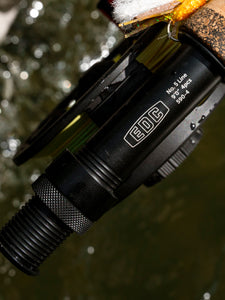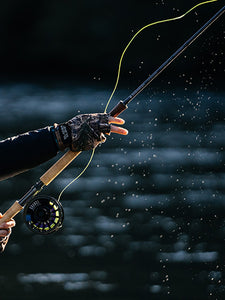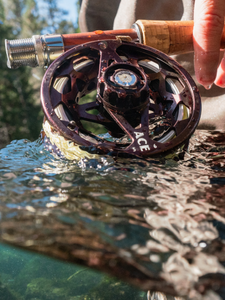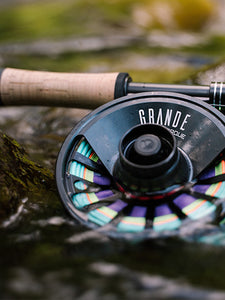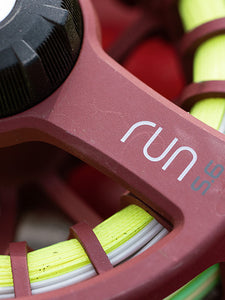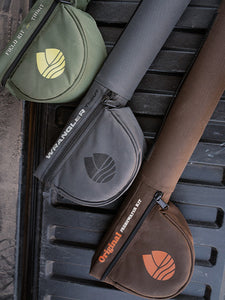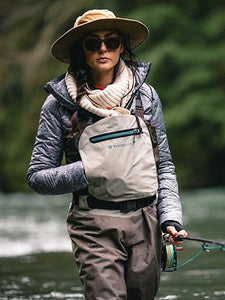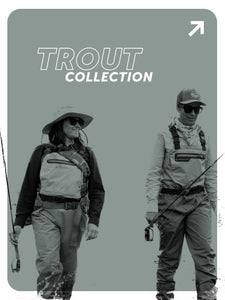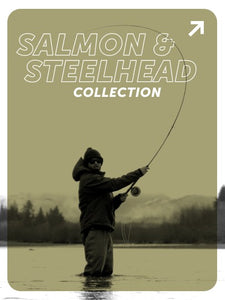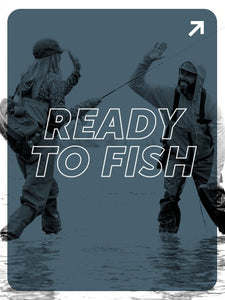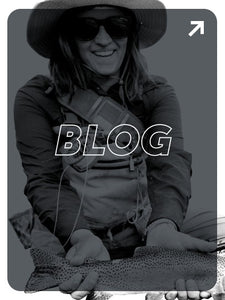
DIY Tarpon on The Fly
I want to start off by saying I am no means a pro saltwater fisherman; I would consider myself a newbie at best. I have gone with a saltwater guide once in Puerto Rico to chase tarpon and other than that my only salt experience has been surf fishing from the beach on family vacations. A lot of research and a good run of luck can go a long way when traveling to a place you’ve never fished before!
This past summer my husband and I ventured to Maine where we had a sad attempt at some striper fishing. Apparently, we were two months late to the dance, but we had fun and got some casting practice in. On the way back from this trip - reminiscing about what we did catch (brookies!) and our failed attempt at striped bass, we decided we wanted to scheme up an affordable saltwater trip.
After some research and exchanging ideas with friends we went back and forth between attempting stripers again or doing something completely different and going for bonefish and tarpon in the Florida Keys. Over dinner (and a few cocktails) the decision was made – we were leaving for the Keys in less than three weeks to hunt some saltwater creatures in the Keys.

When I started to research fishing opportunities for this trip, I was pretty discouraged – every forum I read and even when reaching out to people everyone said to hire a guide. Which I am not opposed to, but our budget was tight, and I was determined to get fish on my own. The further I went down the Florida Keys fly fishing rabbit hole I saw that some folks would rent kayaks to venture out to the flats where they would find cruising bonefish, tarpon, and even permit! Kayaks are generally cheap to rent, especially compared to a skiff so we made reservations to rent two fishing kayaks for three days.
Arriving to the Keys after a 22-hour drive from New York I felt a little overwhelmed by, well, the water… there is SO much water. I had done a lot of google earth investigative work beforehand, but I still wasn’t overly confident I picked the right spots.
Our first day and a half on the water was rough – we caught a couple mangrove snapper, small barracuda, and other small species that weren’t on the target list. These days we stayed generally close to camp and fished some flats that ended up being a bit deeper than I thought they would be, even though we didn’t catch a ton we had a riot paddling around new areas, seeing sharks, sea turtles, and baking in the sun. Over dinner that night we decided to try and fish some more secluded areas away from the popular beaches.
On day two we were both ready for big fish – we practiced our hauling, and strip sets on a school of barracuda the night before (a great way to practice streamer fishing on the flats, especially getting those strip-sets down which is what I struggle with most being a trout fisherman). We woke up early the second day to get to a secluded little area with a mangrove shoreline that had a beautiful looking flat that was a two-mile paddle from the launch. I had a really good feeling about that flat holding bonefish or even maybe a tarpon cruising through.
We arrived at the launch at sunrise, it was covered in dead sea grass. As we unloaded the boats a local fisherman showed up to put his skiff in the water and started telling stories about the bonefish and permit he had caught on the flat that I was planning on paddling to. I was READY to start chasing after bonefish.
I had never packed up my fishing gear so quickly, I rigged up my 9wt predator rod with a bonefish leader and tied on a bonefish bitters fly (it had bonefish in the name it must work right?). I left my husband in my wake as I pushed myself through the thick, stinky seagrass, and started the paddle to my flat, the glorious flat that has my hungry, drag screaming bonefish I’ve been waiting for sitting on it.

A few minutes into my paddle, I hear Derek yell my name, “Payton! Payton!! There are fish jumping everywhere! Tarpon! They have to be tarpon!” I wasn’t expecting tarpon, I don’t really know why. I just had bonefish on the brain. Looking back this was the perfect place that would hold resident and juvenile fish; a deep channel that is adjacent to a mangrove shoreline with tons of seagrass cover. I turned around and they were everywhere, hitting the surface, gulping air, how did I not see these fish when I was paddling out?
As soon as I started paddling back towards him, Derek hooked up with a big tarpon. After only a few casts, he was using a spinning rod with a big white swimbait. As quickly as he hooked this fish the fish got off. At this point I knew this what we would be targeting for the day and probably for the rest of the trip.
I frantically rigged up my tarpon leader and tied on a Rio Dread Pirate fly on the 9wt (I would recommend maybe a 10 or 11wt in this situation but the 9wt ended up working out perfect and held it’s own even against the bigger fish). I could see that fish were hitting the surface and this fly was the perfect choice to get me under the surface a little bit without getting hung up on all the seagrass. Under further investigation I found that the tarpon were feeding on shrimp and crabs that were nestled in the seagrass.

The next 45 minutes or so was pure chaos, we both hooked into 2 or 3 different fish but could not land them. Derek found out that the spinning rod wasn’t going to cut it – the flies were light enough to not get caught so bad in the weeds, so he rigged up on his 8wt Vice rod and threw a tarpon toad. After this first wave of activity the fish seemed to become less active and weren’t coming to the surface as much. When the ciaos died down we paddled up close to each other and came up with a game plan. We needed to target the fish on the edges of the weed beds rather than the pockets. When each of us hooked into fish in deep cover they would bury themselves in the thickest weeds they could and would eventually end up getting themselves unhooked.
After we rallied with our game plan it was back to fishing – the movement of fish had slowed down, but they were still there. Casting out of the kayak wasn’t easy, Derek could stand and cast but I wasn’t quite that coordinated in my boat so I casted sitting down. After the first hour or so I got in a rhythm doing this and ended up being able to cast pretty accurately.

I was finally able to hook into a tarpon that I was confident in landing. I saw his dorsal fin peak out of the water in an open area and casted about a foot in front of where I thought his face was. I made two slow strips and could see him pushing water behind the fly, he was on the hunt! One more strip and he grabbed it and took off, I finally got that perfect strip set I had been working at.
This fish put on a show for us, he took drag, had a few long fast runs, and gave us the typical tarpon acrobat show. We worked as a team getting this fish to the side of the boat and finally got him under control. He was about a 35-inch juvenile tarpon, the perfect size to land in a kayak! We snapped a few quick pictures and sent him on his way! SUCCESS! We got a tarpon!
I could not have been happier about that fish, we ended up targeting tarpon for the next few hours until around lunch time. We had a lot of hookups but still struggled to land them. I got one very small juvenile in by myself, and we were now on a mission to get Derek his first tarpon!
CLCIKHe had hooked into a few that morning but they just didn’t seem to want to stick, he even had a few just inches away from the boat where they would spit the hook. I knew we would be back to the same spot the next morning to try and get him a fish. That was our last day of the trip, and the pressure was on.
The next morning, we were back at it, but where were the fish? The water was as calm as could be and it didn’t seem like any fish were moving around like they were the day before. We ended up paddling around the Key in hopes to find the same pod of fish feeding somewhere close by. We saw some single fish cruising and I caught one of these fish on a tarpon toad while trying to find the pod. This was the most aggressive fish I had hooked into on the trip and put up one hell of a fight trying to get it to the boat. After this fish we started to see more and more activity at the surface, and we eventually ended up finding a big pod of fish around 10 AM.

Then the chaos began again, there were fish everywhere. Hundreds of tarpon started to hit the surface all around us. This was Derek’s chance; I was spotting fish and he was casting perfectly to them. It would only be a matter of time until one decided to eat. He made a perfect cast on a fish that had just surfaced, the fish waked behind his fly and then BAM fish on! We were in the perfect spot to land this fish with the water being more open. After an epic battle he was able to get the fish boat side, we snapped a few pictures and released the fish back to mangroves. SUCCESS!
After this fish I think we both let out a sigh of relief and had a sense of accomplishment knowing we had met our goal. The rest of that afternoon we fished around that pod of fish catching a few and losing a lot of more. We ended up landing 6 total tarpon on our trip, they weren’t the giant migratory fish you see get promoted around the Keys, but they were a riot to target and aggressive feeders.
I never did end up seeing a bonefish on this trip, let alone catch one. I came into this trip not really knowing what to expect, I had read a lot of stories from other anglers success and failures but wasn’t sure where we would end up landing between the two. I think being flexible and prepared on fishing trips is important, especially saltwater trips. I was prepared for a variety of different saltwater species, even though I didn’t think our timing would be great for tarpon that ended up being our primary target species.
If you are planning a DIY saltwater trip, I would do some research on the area you are going to fish. There are a lot of great resources to find information on what species to target, what fish you can catch, and what to look for at different spots. I used google earth a lot in my research to find flats that looked like they would hold fish. Locals are another awesome source to find intel, everyone I talked to at the fly and tackle shops were very helpful and willing to chat about how the fishing had been and gave some good spots to try fishing.
Saltwater fishing doesn’t have to cost a million dollars to get into, and your next saltwater fishing trip can be cheaper than you think! Do your research, learn the water, and stay safe! Happy fishing!

